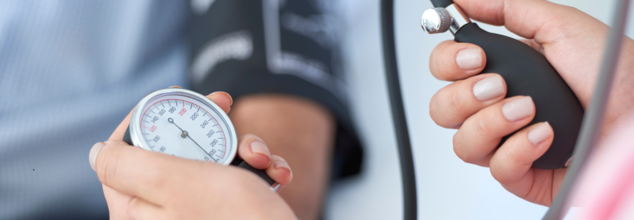- Health Conditions A-Z
- Health & Wellness
- Nutrition
- Fitness
- Health News
- Ayurveda
- Videos
- Medicine A-Z
- Parenting
- Web Stories
World Hypertension Day: The Toll of Anxiety and Social Media That Is Making More Young People Face High Blood Pressure

Credits: Canva
Hypertension, or high blood pressure, is a condition where the force of blood against artery walls is consistently too high. According to the Centers for Disease Control and Prevention (CDC), it's often called the “silent killer” because it typically has no warning signs but can lead to serious heart disease, stroke, and kidney failure over time. The World Health Organization (WHO) defines it as a major global health issue, with over 1.28 billion adults aged 30–79 estimated to have hypertension, most of them unaware of their condition.
Hypertension & the Young: A Growing Concern
While traditionally seen as an older person’s problem, hypertension is now being diagnosed in younger individuals—often silently progressing due to unmanaged mental health issues. According to Ms. Aanchal Choudhary Ahuja, Clinical Psychologist (RCI Recognised), Lissun, one of the major drivers behind this shift is the unique emotional and digital stress young adults face today.
“Social media is tricky,” says Ms. Ahuja. “On one hand, it connects us. On the other, it constantly bombards us with things to compare ourselves to—perfect bodies, perfect lives, perfect careers. That kind of pressure builds quietly.”
The Link Between Hypertension and Mental Health
Hypertension and depression are closely interconnected. Biologically, chronic stress and depression activate the hypothalamic-pituitary-adrenal (HPA) axis, which raises cortisol levels—a stress hormone that, when elevated for long periods, can cause high blood pressure. Psychologically, depression can lead to a lack of self-care, poor diet, and disrupted sleep—all of which are risk factors for hypertension.
“I’ve seen patients come in with symptoms of anxiety and low mood, only to find out they’re also dealing with elevated blood pressure,” Ms. Ahuja explains. “It becomes a vicious cycle, where one condition fuels the other.”
Social Media and the Stress Spiral
Constant scrolling, especially late at night, leads to poor sleep and a sense of falling behind. “You open LinkedIn and suddenly feel like you're not doing enough,” says Ms. Ahuja. “It’s a subtle, constant comparison we don’t even realize we’re making.” Over time, this quiet stress impacts both mental health and cardiovascular health.
One of her clients, a 24-year-old tech employee, came in for therapy due to insomnia and anxiety. She was later found to have early-stage hypertension. “Her daily stress included back-to-back meetings, no breaks, and social media-induced sleep deprivation,” Ahuja recalls.
Signs You Shouldn't Ignore
In young adults, the early symptoms of co-existing hypertension and mental health strain can be subtle. These may include:
- Persistent fatigue
- Difficulty concentrating or brain fog
- Headaches or chest tightness
- Mood swings or emotional numbness
- Loss of interest in hobbies and relationships
“These are the body’s early warning signs,” Ms. Ahuja stresses. “Often, they’re easy to dismiss, but they’re the mind and heart asking for help.”
Long-Term Effects of Digital Overload
Poor sleep, endless comparison, and doom-scrolling quietly alter your baseline stress levels. “These habits, over months or years, change your body. You may feel 'used to it,' but your heart isn’t,” says Ahuja. Chronic stress can eventually lead to hypertension, digestive issues, weakened immunity, and emotional burnout.
Preventive Steps: From Screen Breaks to Therapy
According to Ms. Ahuja, prevention starts with awareness. “Mental health check-ins should be routine, just like blood tests. Even if nothing feels ‘wrong’, it helps catch the buildup of stress early.” She also advocates for regular digital detoxes. “Our brains weren’t designed for constant content. Taking breaks—even just keeping your phone away during meals—can reduce cortisol levels and help reset your nervous system.”
Her Advice to the Overwhelmed
“Don’t wait until it gets bad,” she says. “Waiting for a breakdown to act is like waiting for your car engine to explode before checking the oil.” Her practical suggestions:
- Limit screen time, especially before bed
- Build boundaries between work and rest
- Talk to someone—friend, mentor, or therapist
- Don’t dismiss your feelings just because they don’t seem ‘serious enough’
Want a Better Memory? The Answer Lies in Your Sleep

(Credit-Canva)
Finding your keys, remembering a name, or forgetting what you needed at the store happens to everyone. But while it's normal to be forgetful sometimes, it's also important to take care of your memory.
When you're about to learn something new, sleep is a crucial first step. Scientists have found that sleep before you learn actually prepares your brain to take in new information. Without enough sleep, your ability to learn new things can drop by as much as 40%.
This is because a lack of sleep affects a part of the brain called the hippocampus, which is essential for making new memories.
How Your Brain Works to Store Memories During Sleep
After you've learned something, sleep is even more important. When you first form a memory, it's very fragile. Your brain uses sleep as a special time to go back through recent memories and decide which ones to keep.
During the deep stages of sleep, memories become more stable and firm. Research has even shown that memories for skills, like playing a song on the piano, can actually get better while you're asleep. After deep sleep, REM (Rapid Eye Movement) sleep—the stage where you dream—helps to link related memories together in new and unexpected ways. This is why a full night of sleep can help with problem-solving. REM sleep also helps you process and reduce the intensity of emotional memories.
Link Between Aging, Sleep, and Memory
It's a well-known fact that our sleep patterns change as we get older. Unfortunately, the deep sleep that is so important for strengthening memories starts to decline in our late 30s. A study found that adults over the age of 60 had a 70% loss of deep sleep compared to young adults (ages 18-25). This reduction in deep sleep was directly linked to having a harder time remembering things the next day.
Scientists are now looking into ways to improve deep sleep in older people. Since there are few medical treatments for memory problems in old age, improving sleep could be a very promising way to help people hold onto their memories as they get older. Ultimately, whether you are a student or an older adult, it's important to know that the sleep you get after you study is just as vital as the sleep you get before you study. When it comes to sleep and memory, you get very little benefit from cutting corners.
Some Other Ways To Improve Your Memory
Here are some simple ways you can keep your brain health in check.
Be Active Every Day
Exercise gets blood flowing to your entire body, including your brain. This can help keep your memory sharp. Try to get at least 150 minutes of moderate activity, like walking fast, each week. Even a few 10-minute walks a day can help.
Keep Your Mind Busy
Just like exercise strengthens your body, mental activities keep your brain strong. To help prevent memory loss, try things like reading, doing puzzles, playing games, or learning a new skill or musical instrument.
Spend Time with Others
Being social can help you avoid stress and depression, both of which can lead to memory loss. Make an effort to spend time with friends and family, especially if you live alone.
Stay Organized
When things are messy, it's easy to forget. Use a notebook, calendar, or digital planner to keep track of tasks and appointments. To help remember things, you can repeat them out loud as you write them down. Keep important items like your keys and wallet in the same spot so you can always find them.
Get Enough Sleep
Not getting enough sleep can be linked to memory loss. Aim to get 7 to 9 hours of sleep each night on a regular basis. If snoring or restless sleep is an issue, talk to your doctor, as it could be a sign of a sleep problem.
Eat Healthy Foods
A healthy diet is good for your brain. Make sure to eat plenty of fruits, vegetables, and whole grains. Also, choose lean proteins like fish and beans. Be mindful of how much alcohol you drink, as too much can cause confusion and memory loss.
Manage Health Problems
Follow your doctor's advice for managing any long-term health issues like high blood pressure, diabetes, or depression. Taking good care of your body can help you take better care of your memory. It's also a good idea to talk to your doctor about any medicines you take, as some can affect your memory.
Is Holding A Grudge Only A Woman's Problem? Science Explains The Gender Difference

(Credit-Canva)
The phrase, “hell hath no fury like a woman scorned” may hold more truth than we led on. Women are always thought of as the less aggressive, more forgiving and expected to be more rational than men. However, how much of that is a biological factor and how much of it is societal expectation?
While many people believe women are more forgiving, the results of many studies suggest otherwise. This 1997 research, which was published in the Proceedings of the National Academy of Sciences (PNAS) USA, compared men and women to see if there were differences in how they forgive. The study looked at how forgiving people are in general, as well as how they forgive themselves, others, and situations they can’t control.
Why Women Hold More Grudges
The study, which included 625 people (mostly women), found that men were more forgiving overall than women. Men also showed a greater willingness to move past feelings of unforgiveness. However, when it came to the more positive aspects of forgiveness, like being accepting and compassionate, there was no major difference between the genders.
Both men and women in the study showed similar emotional patterns related to forgiveness. Things like negative emotions, anxiety, and holding in anger were all linked to being less forgiving. On the other hand, positive emotions were linked to being more forgiving. An interesting difference was seen with anxiety control: for women, controlling their anxiety was linked to being less forgiving, but for men, it was linked to being more forgiving.
How Emotions and Gender Affect Forgiveness
The study found that a person's gender can change the way certain emotions are connected to forgiveness. This was especially true for forgiving oneself and forgiving situations that are out of one's control. Forgiveness of others, however, was not significantly affected by these gender differences. This suggests that while everyone's emotions play a role in forgiveness, gender can influence how those emotions shape our ability to let go of certain types of hurt.

Are Men More Forgiving Than Women?
Another 2021 study, published in the Journal of Religion and Health, on average, men were more forgiving than women, especially when it came to overcoming feelings of unforgiveness toward themselves and situations they couldn't control. However, there was no significant difference in the more positive aspects of forgiveness, such as a compassionate mindset.
- The research also found a link between emotions and forgiveness for both genders:
- Negative emotions, like sadness, anxiety, and anger, made it harder for people to be forgiving.
- Positive emotions were associated with being more forgiving.
An interesting finding was how controlling emotions affected men and women differently. For women, trying to control their anxiety was linked to being less forgiving. For men, controlling their anxiety was actually linked to being more forgiving, particularly of themselves and difficult situations.
How Does Serotonin Affect Your Brain?
According to a study published in the Biological Psychiatry, the study showed that when serotonin was low, the connection between two key brain areas became weaker. To find this, researchers adjusted the diets of healthy volunteers to lower their serotonin levels. Using an fMRI brain scan, they observed how the volunteers' brains reacted to faces showing angry, sad, or neutral expressions. They found that these 2 areas of the brain became weak,
- The amygdala, which is the emotional part of the brain that creates feelings of anger.
- The prefrontal cortex, which is the part that helps us regulate and control our emotions.
- This suggests that with low serotonin, it's harder for the prefrontal cortex to manage the anger signals coming from the amygdala. This can make a person more likely to act aggressively.
Why Some People Are More Prone to Aggression
The researchers also gave the volunteers a personality test to see who had a natural tendency toward aggression. They found that in these individuals, the link between the amygdala and the prefrontal cortex was even weaker when serotonin was low. This means that people who are already more prone to aggression are the most sensitive to drops in serotonin, which makes it even harder for them to control their angry feelings.
These findings highlight that while everyone's emotions play a role in forgiveness, gender can influence how those emotions shape a person's ability to let go of certain types of hurt.
Miriam Margolyes, Harry Potter Star Shares Honest Health Update 'I've Let My Body Down'

Actress Miriam Margolyes, known for her role as Professor Sprout in the Harry Potter films, recently spoke openly about her health issues. In a new interview, the 84-year-old admitted her lifestyle has taken a toll on her body, which she links to a lifelong struggle with her weight.
When asked about using Ozempic for weight loss, Margolyes firmly rejected the idea, stating, "That’s for diabetics. You shouldn’t take medicine meant for people who are really sick."
Her health struggles have also led to her considering her own mortality. After a recent heart procedure, she shared that she knows she "doesn’t have long left to live," likely within the next five to six years. Despite this, she expressed a strong desire to continue performing, even though she isn't "strong enough" for roles that don't involve a wheelchair.
Miriam Margolyes Health
In May 2023, Margolyes was hospitalized with a chest infection and underwent a heart procedure. She later updated fans on social media, thanking them for their support.
The procedure she had was a Transcatheter Aortic Valve Implantation (TAVI), a less invasive alternative to open-heart surgery. On a podcast, she explained that she had an aortic valve replaced with one from a cow. "I’ve got a cow’s heart now," she joked. "I’d never heard of that operation, but it saves you from having open heart surgery."
Beyond her heart issues, Margolyes has also been diagnosed with spinal stenosis, a condition that causes chronic pain and makes it difficult for her to walk. She has registered as disabled and uses a walker and sticks, though she recently got a mobility scooter, which she called "a lot of fun."
Could Heart Health Issues Be Avoided With Exercise?
"I’ve let my body down," she said. "I haven’t taken care of it. I have to walk with a walker now. I wish I’d done exercise." Miriam admitted in the magazine interview. According to the National Institute on Aging, being physically active is pertinent for one’s health.
As you get older, your heart and blood vessels naturally change. While your resting heart rate usually stays the same, your heart may not be able to beat as fast as it used to during exercise or stressful situations.
As you get older, it's not unusual to feel your heart flutter or skip a beat from time to time. Most of the time, this is nothing to worry about. But if you feel like your heart is fluttering or racing very often, or if the feeling doesn't go away, it could be a sign of a heart rhythm problem called an arrhythmia. If this happens, it's a good idea to talk to a doctor, as it might need treatment.
How Does Aging Change Your Heart?
With age, your heart’s size and structure can change. The walls of your heart can get thicker, and its chambers can become bigger. This can make it harder for the heart to hold as much blood as it used to. A thicker heart wall also raises the risk for a common heart rhythm issue called atrial fibrillation, which can increase the chance of having a stroke.
The heart’s valves, which open and close to control blood flow, can also get stiffer and thicker. This can slow down or block the blood flow out of your heart, or they can become leaky. When this happens, fluid can start to build up in your lungs, legs, and feet.
How to Protect Your Heart and Brain
The natural changes in your heart that come with age can increase your risk of heart disease, which can limit your daily activities. It’s also interesting to know that many of the things that are bad for your heart are also bad for your brain. For example, high blood pressure can increase your risk of both heart disease and dementia later in life.
The good news is that you can take steps to protect both. By managing your blood pressure and taking good care of your heart, you are also helping to protect your brain and improve your overall well-being as you get older.
© 2024 Bennett, Coleman & Company Limited

